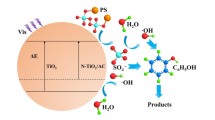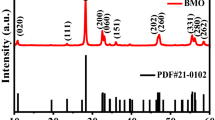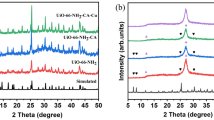Abstract
The massive use of acetaminophen (APAP) poses a potential crisis for humans and the environment. In this paper, the degradation of APAP in aqueous solution was carried out using photocatalytic synergistic persulfate oxidation. To enhance the photocatalytic activity of g-C3N4 and thus activate the persulfate (K2S2O8, PS) more effectively, the heterojunction photocatalyst TiO2/g-C3N4 (TCN) was prepared by a hydrothermal method. The TCN-PS catalytic system showed a high efficiency for APAP degradation. When the amount of TCN and PS added was 0.6 g/L, the degradation rate of APAP at 10 mg/L was 78.3% after 60 min of illumination. Moreover, the TCN-PS catalytic system was effective in removing organic pollutants in acidic, neutral, and weakly alkaline environments. The radical quenching experiment results indicate that both sulfate radicals (SO4−•) and hydroxyl radicals (•OH) are involved in the degradation reaction. After five cycles, the TCN-PS catalytic system still has stable catalytic activity.






Similar content being viewed by others
Data availability
The data is available from the corresponding author on reasonable request.
References
Chen, F., Huang, G., Yao, F., Yang, Q., Zheng, Y., Zhao, Q., & Yu, H. (2020). Catalytic degradation of ciprofloxacin by a visible-light-assisted peroxymonosulfate activation system: Performance and mechanism. Water research., 173, 115559.
Chen, L., Hu, X., Cai, T., Yang, Y., Zhao, R., Liu, C., Li, A., & Jiang, C. (2019). Degradation of triclosan in soils by thermally activated persulfate under conditions representative of in situ chemical oxidation (ISCO). Chemical Engineering Journal, 369, 344–352.
Do, S.-H., Kwon, Y.-J., & Kong, S.-H. (2010). Effect of metal oxides on the reactivity of persulfate/Fe(II) in the remediation of diesel-contaminated soil and sand. Journal of Hazardous Materials, 182, 933–936.
Dombrowski, P. M., Kakarla, P., Caldicott, W., Chin, Y., Sadeghi, V., Bogdan, D., Barajas-Rodriguez, F., & Chiang, S. Y. (2018). Technology review and evaluation of different chemical oxidation conditions on treatability of PFAS. Remediation Journal, 28, 135–150.
Fordham, J. W. L., & Williams, H. L. (1951). The persulfate-iron(II) initiator system for free radical polymerizations. Journal of the American Chemical Society, 73, 4855–4859.
Furman, O. S., Teel, A. L., & Watts, R. J. (2010). Mechanism of base activation of persulfate. Environmental Science & Technology, 44, 6423–6428.
Gao, Y., Zhang, Z., Li, S., Liu, J., Yao, L., Li, Y., & Zhang, H. (2016). Insights into the mechanism of heterogeneous activation of persulfate with a clay/iron-based catalyst under visible LED light irradiation. Applied Catalysis b: Environmental, 185, 22–30.
Ghaly, H. A., El-Kalliny, A. S., Gad-Allah, T. A., El-Sattar, N. E. A. A., & Souaya, E. R. (2017). Stable plasmonic Ag/AgCl–polyaniline photoactive composite for degradation of organic contaminants under solar light. RSC Advances, 7, 12726–12736.
Ghasemi, Z., Younesi, H., & Zinatizadeh, A. A. (2016). Kinetics and thermodynamics of photocatalytic degradation of organic pollutants in petroleum refinery wastewater over nano-TiO2 supported on Fe-ZSM-5. Journal of the Taiwan Institute of Chemical Engineers, 65, 357–366.
Gul, I., Sayed, M., Shah, N. S., Ali Khan, J., Polychronopoulou, K., Iqbal, J., & Rehman, F. (2020). Solar light responsive bismuth doped titania with Ti3+ for efficient photocatalytic degradation of flumequine: Synergistic role of peroxymonosulfate. Chemical Engineering Journal., 384, 123255.
Huo, J., Yuan, C., & Wang, Y. (2019). Nanocomposites of three-dimensionally ordered porous TiO2 decorated with pt and reduced graphene oxide for the visible-light photocatalytic degradation of waterborne pollutants. ACS Applied Nano Materials, 2, 2713–2724.
Kim, P., Park, Y., Ji, K., Seo, J., Lee, S., Choi, K., Kho, Y., Park, J., & Choi, K. (2012). Effect of chronic exposure to acetaminophen and lincomycin on Japanese medaka (Oryzias latipes) and freshwater cladocerans Daphnia magna and Moina macrocopa, and potential mechanisms of endocrine disruption. Chemosphere, 89, 10–18.
Kuldeep, A. R., Dhabbe, R. S. & Garadkar, K. M. (2021). Development of g-C3N4-TiO2 visible active hybrid photocatalyst for the photodegradation of methyl orange. Research on Chemical Intermediates, 47, 5155–5174.
Li, K., Sun, M., & Zhang, W. (2018). Polycyclic aromatic compounds-modified graphitic carbon nitride for efficient visible-light-driven hydrogen evolution. Carbon, 134, 134–144.
Li, L., Yuan, X., Zhou, Z., Tang, R., Deng, Y., Huang, Y., Xiong, S., Su, L., Zhao, J., & Gong, D. (2022). Research progress of photocatalytic activated persulfate removal of environmental organic pollutants by metal and nonmetal based photocatalysts. Journal of Cleaner Production., 372, 133420.
Lim, J. K., Sieland, D.-Y., Kim, F., Bahnemann, C., Choi, D. W., & Wonyong,. (2018). Visible light-induced catalytic activation of peroxymonosulfate using heterogeneous surface complexes of amino acids on TiO2. Applied Catalysis b: Environmental, 225, 406–414.
Lin, K., & Zhang, Z. (2017). Degradation of bisphenol A using peroxymonosulfate activated by one-step prepared sulfur-doped carbon nitride as a metal-free heterogeneous catalyst. Chemical Engineering Journal, 313, 1320–1327.
Lin, L., Ou, H., Zhang, Y., & Wang, X. (2016). Tri-s-triazine-based crystalline graphitic carbon nitrides for highly efficient hydrogen evolution photocatalysis. ACS Catalysis, 6, 3921–3931.
Matzek, L. W., & Carter, K. E. (2016). Activated persulfate for organic chemical degradation: A review. Chemosphere, 151, 178–188.
Ming, H., Zhang, P., Yang, Y., Zou, Y., Yang, C., Hou, Y., Ding, K., Zhang, J., & Wang, X. (2022). Tailored poly-heptazine units in carbon nitride for activating peroxymonosulfate to degrade organic contaminants with visible light. Applied Catalysis B: Environmental., 311, 121341.
Pelaez, M., Nolan, N. T., Pillai, S. C., Seery, M. K., Falaras, P., Kontos, A. G., Dunlop, P. S. M., Hamilton, J. W. J., Byrne, J. A., O’Shea, K., Entezari, M. H., & Dionysiou, D. D. (2012). A review on the visible light active titanium dioxide photocatalysts for environmental applications. Applied Catalysis b: Environmental, 125, 331–349.
Piao, H., & McIntyre, N. S. (2002). Adventitious carbon growth on aluminium and gold-aluminium alloy surfaces. Surface and Interface Analysis, 33, 591–594.
Saputra, E., Muhammad, S., Sun, H., Ang, H.-M., & Tad, eacute, M. O. & Wang, S. (2013). Manganese oxides at different oxidation states for heterogeneous activation of peroxymonosulfate for phenol degradation in aqueous solutions. Applied Catalysis b: Environmental, 142–143, 729–735.
Sudrajat, H. (2018). A one-pot, solid-state route for realizing highly visible light active Na-doped gC3N4 photocatalysts. Journal of Solid State Chemistry, 257, 26–33.
Tan, S., Xing, Z., Zhang, J., Li, Z., Wu, X., Cui, J., Kuang, J., Zhu, Q., & Zhou, W. (2018a). Ti3+-TiO2/g-C3N4 mesostructured nanosheets heterojunctions as efficient visible-light-driven photocatalysts. Journal of Catalysis, 357, 90–99.
Tan, Y., Shu, Z., Zhou, J., Li, T., Wang, W., & Zhao, Z. (2018b). One-step synthesis of nanostructured g-C3N4/TiO2 composite for highly enhanced visible-light photocatalytic H2 evolution. Applied Catalysis b: Environmental, 230, 260–268.
Tao, Y., Ni, Q., Wei, M., Xia, D., Li, X., & Xu, A. (2015). Metal-free activation of peroxymonosulfate by g-C3N4 under visible light irradiation for the degradation of organic dyes. RSC Advances, 5, 44128–44136.
Tian, D., Zhou, H., Zhang, H., Zhou, P., You, J., Yao, G., Pan, Z., Liu, Y., & Lai, B. (2022). Heterogeneous photocatalyst-driven persulfate activation process under visible light irradiation: From basic catalyst design principles to novel enhancement strategies. Chemical Engineering Journal., 428, 131166.
Waclawek, S., Lutze, H., Grubel, K., Padil, V., Cernik, M., & Dionysiou, D. (2017). Chemistry of persulfates in water and wastewater treatment: A review. Chemical Engineering Journal, 330, 44–62.
Wang, J., & Wang, S. (2018). Activation of persulfate (PS) and peroxymonosulfate (PMS) and application for the degradation of emerging contaminants. Chemical Engineering Journal, 334, 1502–1517.
Wang, Y., Yang, W., Chen, X., Wang, J., & Zhu, Y. (2018). Research paper photocatalytic activity enhancement of core-shell structure g-C3N4@TiO2 via controlled ultrathin g-C3N4 layer. Applied Catalysis b: Environmental, 220, 337–347.
Wang, Z., Deng, D., & Yang, L. (2014). Degradation of dimethyl phthalate in solutions and soil slurries by persulfate at ambient temperature. Journal of Hazardous Materials, 271, 202–209.
Xu, H., Wang, D., Ma, J., Zhang, T., Lu, X., & Chen, Z. (2018). A superior active and stable spinel sulfide for catalytic peroxymonosulfate oxidation of bisphenol S. Applied Catalysis b: Environmental, 238, 557–567.
Yang, L., Bai, X., Shi, J., Du, X., Xu, L., & Jin, P. (2019). Quasi-full-visible-light absorption by D35-TiO2/g-C3N4 for synergistic persulfate activation towards efficient photodegradation of micropollutants. Applied Catalysis B: Environmental., 256, 117759.
Yang, Q., Ma, Y., Chen, F., Yao, F., Sun, J., Wang, S., Yi, K., Hou, L., Li, X., & Wang, D. (2019). Recent advances in photo-activated sulfate radical-advanced oxidation process (SR-AOP) for refractory organic pollutants removal in water. Chemical Engineering Journal., 378, 122149.
Yang, Y., Guo, Y., Liu, F., Yuan, X., Guo, Y., Zhang, S., Guo, W., & Huo, M. (2013). Preparation and enhanced visible-light photocatalytic activity of silver deposited graphitic carbon nitride plasmonic photocatalyst. Applied Catalysis b: Environmental, 142–143, 828–837.
Zada, A., Qu, Y., Ali, S., Sun, N., Lu, H., Yan, R., Zhang, X., & Jing, L. (2018). Improved visible-light activities for degrading pollutants on TiO2/g-C3N4 nanocomposites by decorating SPR Au nanoparticles and 2,4-dichlorophenol decomposition path. Journal of Hazardous Materials, 342, 715–723.
Zhang, G., Sun, Y., Zhang, C., & Yu, Z. (2017). Decomposition of acetaminophen in water by a gas phase dielectric barrier discharge plasma combined with TiO2-rGO nanocomposite: Mechanism and degradation pathway. Journal of Hazardous Materials, 323, 719–729.
Zhang, L., Hu, J., Zhu, R., Zhou, Q., & Chen, J. (2013). Degradation of paracetamol by pure bacterial cultures and their microbial consortium. Applied Microbiology & Biotechnology, 97, 3687–3698.
Zhang, L., Yin, X., & Li, S. F. Y. (2015). Bio-electrochemical degradation of paracetamol in a microbial fuel cell-Fenton system. Chemical Engineering Journal, 276, 185–192.
Zhang, S., Song, S., Gu, P., Ma, R., Wei, D., Zhao, G., Wen, T., Jehan, R., Hu, B., & Wang, X. (2019a). Visible-light-driven activation of persulfate over cyano and hydroxyl group co-modified mesoporous g-C3N4 for boosting bisphenol A degradation. Jouranl of Materials Chemistry A, 7, 5552–5560.
Zhang, T., Liu, Y., Rao, Y., Li, X., Yuan, D., Tang, S., & Zhao, Q. (2020). Enhanced photocatalytic activity of TiO2 with acetylene black and persulfate for degradation of tetracycline hydrochloride under visible light. Chemical Engineering Journal., 384, 123350.
Zhang, Y., Xiao, Y., Zhong, Y., & Lim, T.-T. (2019b). Comparison of amoxicillin photodegradation in the UV/H2O2 and UV/persulfate systems: Reaction kinetics, degradation pathways, and antibacterial activity. Chemical Engineering Journal, 372, 420–428.
Zhou, G., Sun, H., & Wang, S. (2011). Titanate supported cobalt catalysts for photochemical oxidation of phenol under visible light irradiations. Separation and Purification Technology, 80, 626–634.
Zhou, H., Lai, L., Wan, Y., He, Y., Yao, G., & Lai, B. (2020). Molybdenum disulfide (MoS2): A versatile activator of both peroxymonosulfate and persulfate for the degradation of carbamazepine. Chemical Engineering Journal., 384, 123264.
Zhou, L., Zhang, H., Sun, H., Liu, S., Tade, M., Wang, S., & Jin, W. (2016). Recent advances in non-metal modification of graphitic carbon nitride for photocatalysis: A historic review. Catalysis Science & Technology, 6, 7002–7023.
Zhou, Z., Liu, X., Sun, K., Lin, C., Ma, J., He, M., & Ouyang, W. (2019). Persulfate-based advanced oxidation processes (AOPs) for organic-contaminated soil remediation: A review. Chemical Engineering Journal, 372, 836–851.
Zou, X., Sun, Z., & Hu, Y. (2020). g-C3N4-based photoelectrodes for photoelectrochemical water splitting: A review. Journal of Materials Chemistry A, 8, 21474–21502.
Funding
This work was supported by State Key Laboratory of NBC Protection for Civilian (SKLNBC2021-14).
Author information
Authors and Affiliations
Contributions
Huize Jiang and Jinge Yang contributed to the study conception and design. Material preparation, data collection, and analysis were performed by Huize Jiang, Xinxin Wang, Aihong Wang, Yuzhi Li, and Jinyu Wang. The first draft of the manuscript was written by Huize Jiang, and all authors commented on previous versions of the manuscript. All authors read and approved the final manuscript.
Corresponding author
Ethics declarations
Ethics Approval
Not applicable.
Consent to Participate
Not applicable.
Consent for Publication
Not applicable.
Competing Interests
The authors declare no competing interests.
Additional information
Publisher's Note
Springer Nature remains neutral with regard to jurisdictional claims in published maps and institutional affiliations.
Rights and permissions
Springer Nature or its licensor (e.g. a society or other partner) holds exclusive rights to this article under a publishing agreement with the author(s) or other rightsholder(s); author self-archiving of the accepted manuscript version of this article is solely governed by the terms of such publishing agreement and applicable law.
About this article
Cite this article
Jiang, H., Yang, J., Wang, X. et al. Efficient Activation of Persulfate by TiO2/g-C3N4 Composite for Degradation of Acetaminophen Under Visible Light. Water Air Soil Pollut 234, 619 (2023). https://doi.org/10.1007/s11270-023-06638-5
Received:
Accepted:
Published:
DOI: https://doi.org/10.1007/s11270-023-06638-5




